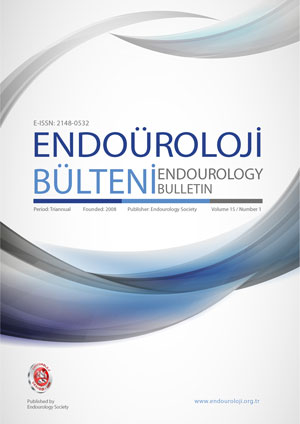
Editorial Board Message
Prof.Dr. R. Gökhan ATIŞ
Editorial Borad
Arbitrators List
Contents
Original Article
Predicting Factors of The Success Rate of Extracorporeal Shock Wave Lithotripsy in Ureteral Stones: A Retrospective Evaluation with Large Patient Participiant
Ali Haydar Yılmaz, Şaban Oğuz Demirdöğen, Hüseyin Koçakgöl, Bakytbek Kozubaev, Salih Al
Abstract
Objective: In our retrospectively planned study; treated with ESWL method; we aimed to investigate the factors that predict the success of Extracorporeal Shock Wave Lithotripsy (ESWL) and its reliability in our patients with ureteral stones.
Material and Methods: The study includes 489 patients treated for ureteral stones at Atatürk University Urology Clinic between 2008 and 2013. Patients underwent a maximum of three sessions of ESWL. Those who had fractures within two sessions were considered successful. Patients who underwent ESWL due to ureteral stones were retrospectively examined from hospital records. In predicting ESWL success, parameters such as gender, age, opacity, side and complication rates, and the need for additional procedures were evaluated. In patients who were stone-free after ESWL or had residual stones smaller than 4 mm on control imaging, ESWL was considered successful and stonefree
was achieved. Sedoanalgesia was applied only to pediatric patients.
Results: A total of 486 patients who underwent ESWL for ureteral stones were included in the study. The patients were divided into 3 groups according to age groups. Ages 1-18 were the first group, ages 20-40 were the second group, and people over 40 were the third group. Stone-free status was not statistically significant in terms of age groups and gender parameters. As a complication, stone street developed in 3 patients and hematuria developed in 2 patients. No significance was found between complications and the location of the stones (p=0.531). There was a significance between stone size and stone-free status and the development of complications (p=0.016, p=0.0001, respectively).
Conclusion: It is essential to predict treatment success in ESWL and to protect patients from complications, time loss and morbidity that may arise from unnecessary treatment and procedures. In our study with large patient participation, we showed that ESWL is a method that can be safely preferred in ureteral stones with high success and low complication rates. In our study, stone size was found to be an important predictive value in predicting success.
Keywords: extracorporeal shock wave lithotripsy, ureteral stones, complication, stone free
Original Article
Investigating the Influence of Tutukon and Alfuzosin on Stone Expulsion After Retrograde Intrarenal Surgery
Muharrem Baturu, Ömer Bayrak, Mehmet Öztürk, Özcan Sevim, Haluk Sen, Ilker Seckiner
Abstract
Objective: To compare the effects of an alpha-blocker (alfuzosin) versus a herbal agent, “Tutukon®,» on stone-free rates in patients who underwent retrograde intrarenal surgery (RIRS).
Material and Methods: We evaluated seventy-five patients who underwent RIRS prospectively consecutively and reported retrospectively between January 2020 and June 2020. Patients were divided into three groups to analyze the effect of medications on stone-free rates after RIRS. “Tutukon®» was prescribed to the first group, alfuzosin 10 mg to the second group, and only dexketoprofen to the third group as the control group. The patients were re-evaluated for stone-free rates after the fourth week of surgery.
Results: Among the groups (Tutukon®/Alfuzosin/Control), no differences were observed in terms of age (44.4±15.71/43.16±14.05/46.00±14.43), stone size, stone location and extracorporeal shock wave lithotripsy (ESWL) history (p>0.05). Complete stone-free rates at the fourth postoperative week; Group 1 (Tutukon®) was 96%, group 2 (alfuzosin) 84%, and group 3 (control) 76% (p=0.163), and the stone-free rate in Group 1 was significantly higher than that in the control group (Group 1 vs. 3; p= 0.044, Group 2 vs. 3; p=0.363). Evaluation of completely stone-free patients and patients with clinically insignificant residual stones showed no difference between the groups (p=0.234).
Conclusion: The data obtained from the use of Tutukon® have similar results to the use of alfuzosin in medical expulsive therapy, suggesting that it may be a preferred phytotherapy method for fragment expulsion after endoscopic stone surgery.
Keywords: medical expulsive treatment, urolithiasis, herbal agent, alfa blocker, and retrograde intrarenal surgery
Original Article
Emergency Placed Percutaneous Nephrostomy Catheter Provides Safe and Effective Access for Future Percutaneous Nephrolithotomy Operation
Kamil Gokhan Seker, Yusuf Arıkan, Deniz Noyan Ozlu, Ali Ayten, Aysun Erbahceci Salık, Ekrem
Guner
Abstract
Objective: It was aimed to investigate the feasibility of the percutaneous nephrostomy (PCN) catheter placed in an emergency in the future percutaneous nephrolithotomy (PNL) operation.
Material and Methods: Patients who underwent PCN catheter insertion by an interventional radiologist under emergency situations prior to PNL surgery between January 2013 and December 2018 were included in the study. Demographic characteristics, indication for PCN insertion, stone characteristics, pre- and post-operative laboratory values, intra-operative data, usability/non-usability of PCN catheter for renal access, post-operative data and complications were recorded.
Results: A total of 32 patients were included in the study. (PCN usable: 21, unusable: 11). Indications for catheter insertion were obstruction in 26 (81.25%) patients and urinary tract infection in 6 (18.75%) patients. Renal access was achieved in 21 (65.62%) patients by using the PCN catheter tract during PNL. The most common PCN access was used in the inferior pole. In 11 (34.37 %) patients, the PCN tract was not usable for access. In patients in whom PCN was unusable due to an unsuitable calyx for access, the most common new access site was the inferior calyx in 6 patients, the superior calyx in 3 patients and the middle calyx in 2 patients. There was no statistically significant difference between the two groups in which the PCN catheter was usable and unusable for PNL access (p>0.05), except for the
mean length of hospital stay (p=0.039).
Conclusions: PCN catheters inserted prior to PNL surgery can be used effectively and safely for renal access during surgery. However, in emergency cases, it is important that the PCN catheter is inserted through the appropriate calyx in patients undergoing future surgery.
Keywords: nephrolithotomy, percutaneous nephrostomy, renal access, interventional radiology, stone
Original Article
Urologists’ Approach to Nocturia: Routine vs. Standardized Approach
Ozgur Kazan, Okan Alkis, Bekir Aras
Abstract
Objective: We aimed to compare the effect of urologists’ routine approach and standardized approach on disease management and treatment results in patients suffering from nocturia.
Material and Methods: The study was designed as a non-randomized prospective cohort study between March and July 2023. In the first stage, the routine clinical approach of 6 urology specialists was evaluated. Demographic data, comorbidities, baseline nocturia number, quality of life, and multidisciplinary approach preference of the patients were recorded (Group 1). In the second stage, the patients’ demographic data, comorbidities, and additionally the voiding diary and “Targeting the individual’s Aetiology of Nocturia to Guide Outcomes” (TANGO) questionnaire were questioned (Group 2). All patients were re-evaluated in the first month of the treatments/recommendations given. The difference in the multidisciplinary approach and the change in the number of nocturia and the quality of life of the patients were compared between the two approaches.
Results: Forty-seven patients were included in each group. The demographic and clinical characteristics of the patients in both groups were statistically similar. Charlson’s comorbidity index was higher in Group 2 (p=0.01). The multidisciplinary treatment approach was at a higher level in Group 2 (59.6% vs 8.5%, p=0.001). While the average number of nocturia decreased from 4.6 to 2.19 in group 1, it decreased from 5.15 to 1.21 in group 2. In the first month, the number of nocturia and quality of life scores were lower in group 2. The decrease in the average number of nocturia and quality of life in group 2 was statistically significantly higher than in group 1.
Conclusion: In the approach to nocturia, questioning comorbidities and applying multidisciplinary management provides more meaningful results in nocturia treatment and increase the quality of life.
Keywords: lower urinary tract symptoms, multidisciplinary, nocturia, questionnaire, quality of life
Review
International Urolithiasis Union (IAU) Retrograde Intrarenal Surgery Guide
Cahit Şahin, Emre Burak Şahinler, Salih Yıldırım, Kemal Sarıca
Abstract
The purpose of the review is to set out the second guidelines on the treatment of urolithiasis by the International Alliance of Urolithiasis that concerns retrograde intrarenal surgery (RIRS).
While creating the recommendations, the PubMed database, systematic reviews and evaluations were used to scan the literature on RIRS published between January 1, 1964 and October 1 2021, and the “modified GRADE” methodology was used for the recommendations. Besides, the level of evidence for the recommendations was determined based on the “Oxford Center for Evidence-Based Medicine Levels of Evidence System” criteria.
Regarding RIRS clinical applications, contraindications; preoperative imaging; preoperative stent placement; preoperative medications; perioperative antibiotics; management of antithrombotic therapy; anesthesia; position of the patient; required tool infrastructure; lithotripsy; 36 recommendations covering surgery termination and complications were developed and graded.
The series of recommendations have been along with the related commentary and supporting documentation in order to obtain effective and safe results in RIRS.
Keywords: guideline, urolithiasis, treatment, retrograde intrarenal surgery, RIRS, flexible ureterorenoscopy, kidneystone, endourology











